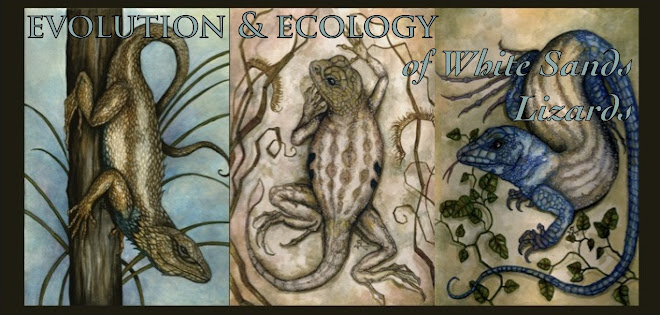 |
| Light coloured male Collared Lizard (Crotaphytus collaris) temporarily in captivity |
Two days ago, I was pacing around a scrubby 'marginal' dune site and what I immediately thought was an oversized H. maculata, dashed bipedally towards a small cottonwood tree at the edge of a dune. I yelled at Mikki that I just saw something HUGE and I thought it was a Gambelia because of the size. We stalked up to the tree and Mikki pointed out a large A. inornata and suggested maybe that was what I saw. Pssh, field assistants, I thought. This dragon had a huge head and stood like four feet off the ground. Er, well, maybe four inches. Anyway, after a few minutes we were turning our backs on the cottonwood to hunt down less menacing creatures, when Mikki looked back and said she saw something HUGE on the dune. Now, I need remind you that when you're hunting dragons of a miniscule size (2 inches, 5 cm), anything > four looks mighty formidable. Well, we went after that beast of a lizard, soon discovering that it was a very lightly coloured male collared lizard- rarely seen this far into White Sands. Collared lizards have large heads for their size and a bite force to match. Perhaps it was my fear of being attacked by this chipmunk-sized reptile that made us take nearly forty-five minutes to catch the fellow. Or, it could have been something to do with our lack-of-water-induced exaggeration-hallucinations.
First of all, I had to create a new noose. Usually we use a 1.5 cm diameter slip-knot loop at the end of a pup-fish pole to capture lizards. I had to fashion a new, 4 cm noose to better accomplish the task. Turns out, getting a dental floss loop over something that large is actually pretty easy, and as I was pulling him out of the branches, my pole all a bent, his mouth all open, I thought, okay, what am I going to do with this biting machine?
So second I put him on the ground all tangled in floss and in quite a rage. As sort of a test I offered him the brim of Mikki's hat. Yeah. He chomped right into that and didn't let go. Well that made it easier. I wrapped my hand around him securely, thumb and forefinger pressing his jaws down onto the hat. I tried to loosen the noose around him, but quickly realized with the hat in his mouth, I could only get so far. So I remembered stomach flushing lizards last field season and how I used a toothpick to keep their mouths open while I induced them to barf... I took a thin stick and wedged it between his upper and lower jaw like a horse-bit. I then could get the loop over his head and drop him quickly into a cage.
We're going to take a tail tip (for genetic work), some colour specs and photos of our vicious fellow before returning him to the interdune. He was quite light for a collared lizard, and it will be interesting to see if he is unique genetically and morphologically. Perhaps these small-lizard predators are finally encroaching on the White Sands...
PS. Mikki saw ANOTHER light collared lizard in the same interdune today! The first is still in captivity, so we know that there is more than one possibly chomping on our study species!

No comments:
Post a Comment